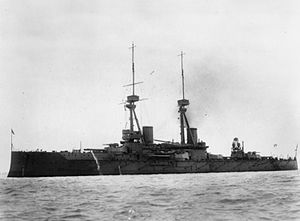HMS Superb (1907)

HMS Superb shortly after completion
|
|
| History | |
|---|---|
|
|
|
| Name: | HMS Superb |
| Ordered: | 1906 |
| Builder: | Armstrong Whitworth |
| Yard number: | 800 |
| Laid down: | 6 February 1907 |
| Launched: | 7 November 1907 |
| Commissioned: | 29 May 1909 |
| Decommissioned: | 26 March 1920 |
| Fate: | Sold for scrap 1922 |
| General characteristics | |
| Class and type: | Bellerophon-class battleship |
| Displacement: | 18,600 long tons (18,900 t) (normal); ~22,000 long tons (22,000 t) (full load) |
| Length: | 490 ft (150 m) (p.p.); 526 ft (160 m) (o/a) |
| Beam: | 82 ft 6 in (25.15 m) |
| Draught: | 27 ft 3 in (8.31 m) (mean); 30 ft 11 in (9.42 m) (maximum) |
| Installed power: | 25,375 shp (18,922 kW) (trials); 23,000 shp (17,000 kW) (service) |
| Propulsion: |
|
| Speed: | 21 kn (24 mph; 39 km/h) (trials); 20.75 kn (23.88 mph; 38.43 km/h) (service) |
| Range: | 5,000 nmi (5,800 mi; 9,300 km) at 19 kn (22 mph; 35 km/h); 6,600 nmi (7,600 mi; 12,200 km) at 10 kn (12 mph; 19 km/h) |
| Capacity: | Coal: 900 tons (normal), 2,648 tons (maximum); Fuel Oil: 842 tons; "Patent Fuel": 170 tons |
| Complement: | 840 |
| Armament: |
|
| Armour: |
|
HMS Superb was a Bellerophon-class battleship of the British Royal Navy. She was built in Elswick at a cost of £1,744,287, and was completed on 19 June 1909. She was only the fourth dreadnought-type battleship to be completed anywhere in the world, being preceded only by HMS Dreadnought and by her two sister ships HMS Bellerophon and HMS Temeraire.
The advent of HMS Dreadnought produced a significant pause in the battleship building programmes of France, Germany and The United States of America, caused by the realisation that new ships would have to match her capabilities. In order to capitalise on this pause the succeeding class of ships, the Bellerophon-class battleships were built to a design only marginally modified from that of Dreadnought. The same main armament was retained, in the same distribution; the same machinery was installed. There were minor design improvements; the tripod foremast was placed forward of the forefunnel, to reduce the likelihood of the topmast spotting position being smoked out; and the mainmast became a full-size tripod, unlike the diminutive mainmast carried by Dreadnought. As this mast was placed forward of the after funnel, however, the spotting position it carried was itself likely to be rendered unusable by funnel exhaust.
The main armament consisted of ten 12-inch (305mm) 45 calibre Mark X guns, with Mark VIII mountings, arranged in five double turrets. The forward turret, or "A" turret, was positioned on the forecastle. It had an unobstructed arc of fire of 270 degrees over the bow. A pair of turrets ("P" and "Q") were positioned, one on either beam, on the maindeck, level with a point between the fore and aft funnels. They had a nominal arc of fire of 180 degrees, from directly forward to directly aft, but in practice firing too close to the superstructure caused unacceptable damage to it. There was no possibility of firing across the deck on the opposite beam. "X" turret was placed at maindeck level between the after funnel and the after superstructure. It had an arc of fire of some 120 degrees on either beam but could not fire either directly aft or forward. "Y" turret was situated on the quarterdeck, also at maindeck level, and had an arc of fire over the stern of some 300 degrees. Eighty rounds per gun were carried.
...
Wikipedia
